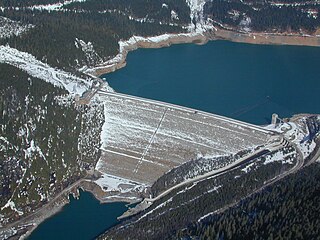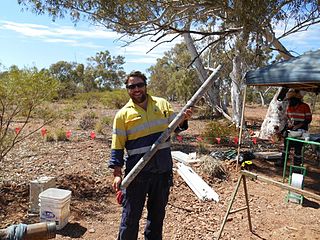
The W. A. C. Bennett Dam is a large hydroelectric dam on the Peace River in northern British Columbia, Canada. At 186 metres (610 ft) high, it is one of the world's highest earth fill dams. Construction of the dam began in 1961 and culminated in 1968. At the dam, the Finlay, the Parsnip and the Peace Rivers feed into Williston Lake, also referred to as Williston Reservoir. It is the third largest artificial lake in North America as well as the largest body of fresh water in British Columbia. Williston Lake runs 250 kilometres north–south and 150 kilometres east–west.
The British Columbia Hydro and Power Authority, operating as BC Hydro, is a Canadian electric utility in the province of British Columbia. It is the main electricity distributor, serving 1.8 million customers in most areas, with the exception of the City of New Westminster, where the city runs its own electrical department and the Kootenay region, where FortisBC, a subsidiary of Fortis Inc. directly provides electric service to 213,000 customers and supplies municipally owned utilities in the same area. As a provincial Crown corporation, BC Hydro reports to the BC Ministry of Energy, Mines and Low Carbon Innovation, and is regulated by the British Columbia Utilities Commission (BCUC). Its mandate is to generate, purchase, distribute and sell electricity.

Mica Dam, a hydroelectric dam spanning the Columbia River 135 kilometres north of Revelstoke, British Columbia, Canada, was built as one of three Canadian projects under the terms of the 1964 Columbia River Treaty and is operated by BC Hydro. Completed in 1973 under the terms of the treaty, the Mica powerhouse had an original generating capacity of 1,805 megawatts (MW). Mica Dam, named after the nearby settlement of Mica Creek and its associated stream, in turn named after the abundance of mica minerals in the area, is one of the largest earthfill dams in the world. The reservoir for the dam is Kinbasket Lake, which was created when the dam was built. Water from the dam flows south directly into Revelstoke Lake, the reservoir for the Revelstoke Dam. Mica Dam is the tallest dam in Canada and second tallest in North America after the Chicoasén Dam in Mexico and it is the farthest upstream dam on the Columbia River. The dam's underground powerhouse was the second largest in the world at the time of its construction, and was the first 500 kV installation of sulphur hexafluoride (SF6) insulated switchgear in the world.

Engineering geology is the application of geology to engineering study for the purpose of assuring that the geological factors regarding the location, design, construction, operation and maintenance of engineering works are recognized and accounted for. Engineering geologists provide geological and geotechnical recommendations, analysis, and design associated with human development and various types of structures. The realm of the engineering geologist is essentially in the area of earth-structure interactions, or investigation of how the earth or earth processes impact human made structures and human activities.
The Columbia River Treaty is a 1961 agreement between Canada and the United States on the development and operation of dams in the upper Columbia River basin for power and flood control benefits in both countries. Four dams were constructed under this treaty: three in the Canadian province of British Columbia and one in the U.S. state of Montana.

Kitimat is a district municipality in the North Coast region of British Columbia, Canada. It is a member municipality of the Regional District of Kitimat-Stikine regional government. The Kitimat Valley is part of the most populous urban district in northwest British Columbia, which includes Terrace to the north along the Skeena River Valley. The city was planned and built by the Aluminum Company of Canada (Alcan) during the 1950s. Its post office was approved on June 6, 1952.
Terzaghi Dam is the key diversion dam in BC Hydro's Bridge River Power Project. It forms the project's largest reservoir, Carpenter Lake west of Lillooet. Originally known as the Mission Dam, it was renamed Terzaghi Dam in 1965 to honor Karl von Terzaghi, the civil engineer who founded the science of soil mechanics. It is located about 30 km up the Bridge River from its confluence with the Fraser.

Ripple Rock is an underwater mountain located in the Seymour Narrows of the Discovery Passage in British Columbia, Canada. It had two peaks that produced large, dangerous eddies from the strong tidal currents that flowed around them at low tide. Ships transiting the strait preferred to wait until slack tide in order to safely bypass the rock.
Sir Alexander Gibb & Partners was a British firm of consulting civil engineers, based at Queen Anne's Lodge, Queen Anne's Gate and subsequently Telford House, Tothill Street, Westminster, London, until 1974, when it relocated to Earley House, 427 London Road, Reading, Berkshire.

Carpenter Lake, officially Carpenter Lake Reservoir, is the largest of the three reservoirs of the Bridge River Power Project, which is located in the mountains west of Lillooet, British Columbia. The lake is about 185 kilometres north of the province's major city of Vancouver and is formed by the 1951 diversion of the Bridge River by Terzaghi Dam into Seton Lake via a tunnel through Mission Mountain, which separates the Seton and Bridge drainages. Several ranches and homesteads in the broad serpentine of the upper Bridge River basin were flooded out by the hydro project, which changed the character of the upper valley forever.

Kemano was a settlement situated 75 km (47 mi) southeast of Kitimat in the province of British Columbia in Canada. It was built to service a hydroelectric power station, built to provide energy for Alcan to smelt aluminum from its ore. The Kemano Generating Station is built 427 m (1,400 ft) inside the base of Mt Dubose in a blasted cavern. It produces 896 MW of power from its eight generators, each of which has a capacity of 112MW.

William Henry Mathews (1919–2003) was a Canadian geologist, volcanologist, engineer, and professor. He is considered a pioneer in the study of subglacial eruptions and volcano-ice interactions in North America. Many of his publications continue to be regarded as classics in their field.
FortisBC is an electricity and natural gas distribution utility in the Canadian province of British Columbia, a subsidiary of Newfoundland-based Fortis Inc., Canada’s largest private utility company. In March 2011, Terasen Gas, British Columbia's largest natural gas distributor, was renamed FortisBC Energy Inc., as both companies are owned by Fortis Inc.
The Kenney Dam is a rock-fill embankment dam on the Nechako River in northwestern British Columbia, built in the early 1950s. The impoundment of water behind the dam forms the Nechako Reservoir, which is also commonly known as the Ootsa Lake Reservoir. The dam was constructed to power an aluminum smelter in Kitimat, British Columbia by Alcan, although in the late 1980s the company increased their economic activity by selling excess electricity across North America. The development of the dam caused various environmental problems along with the displacement of the Cheslatta T'En First Nation, whose traditional land was flooded.

Leechtown is a ghost town on Vancouver Island in British Columbia, Canada.

The Jordan River Dam, officially the Jordan River Diversion Dam, and known locally simply as Diversion Dam, is a dam located in Jordan River, British Columbia, Canada. It is part of the second hydroelectric development on Vancouver Island.

The Nechako Reservoir, sometimes called the Ootsa Lake Reservoir, is a hydroelectric reservoir in British Columbia, Canada that was formed by the Kenney Dam making a diversion of the Nechako River through a 16-km intake tunnel in the Kitimat Ranges of the Coast Mountains to the 890 MW Kemano Generating Station at sea level at Kemano to service the then-new Alcan aluminum smelter at Kitimat. When it was constructed on the Nechako River in 1952, it resulted in the relocation of over 75 families. It was one of the biggest reservoirs built in Canada until the completion of the Columbia Treaty Dams and the W.A.C. Bennett Dam that created Lake Williston. The water level may swing 10 feet between 2790 and 2800 feet.

The Site C Dam is an under construction run-of-the-river hydroelectric dam on the Peace River near Fort St. John in northeastern British Columbia, Canada. It is located approximately 80 kilometres downstream from the W. A. C. Bennett Dam. When completed in 2024, the Site C Dam will become the 4th largest producer of hydroelectricity in British Columbia with an installed capacity of 900 MW and an expected annual output of 5,100 GWh of electricity.

The Cheslatta Carrier Nation or Cheslatta T'En, of the Dakelh or Carrier people (Ta-cullies, meaning "people who go upon water", whose traditional lands where originally where the Kitimat Kemano Project I was built, form a large portion of the Central Interior of present-day British Columbia, Canada, is a First Nation of the Nechako River at the headwaters of the Fraser River.

The John Hart Dam is one of three hydroelectric dams on the Campbell River, located on Vancouver Island in British Columbia, Canada. The dam is located at the outflow of John Hart Lake. The John Hart Generating Station is located nearby.











